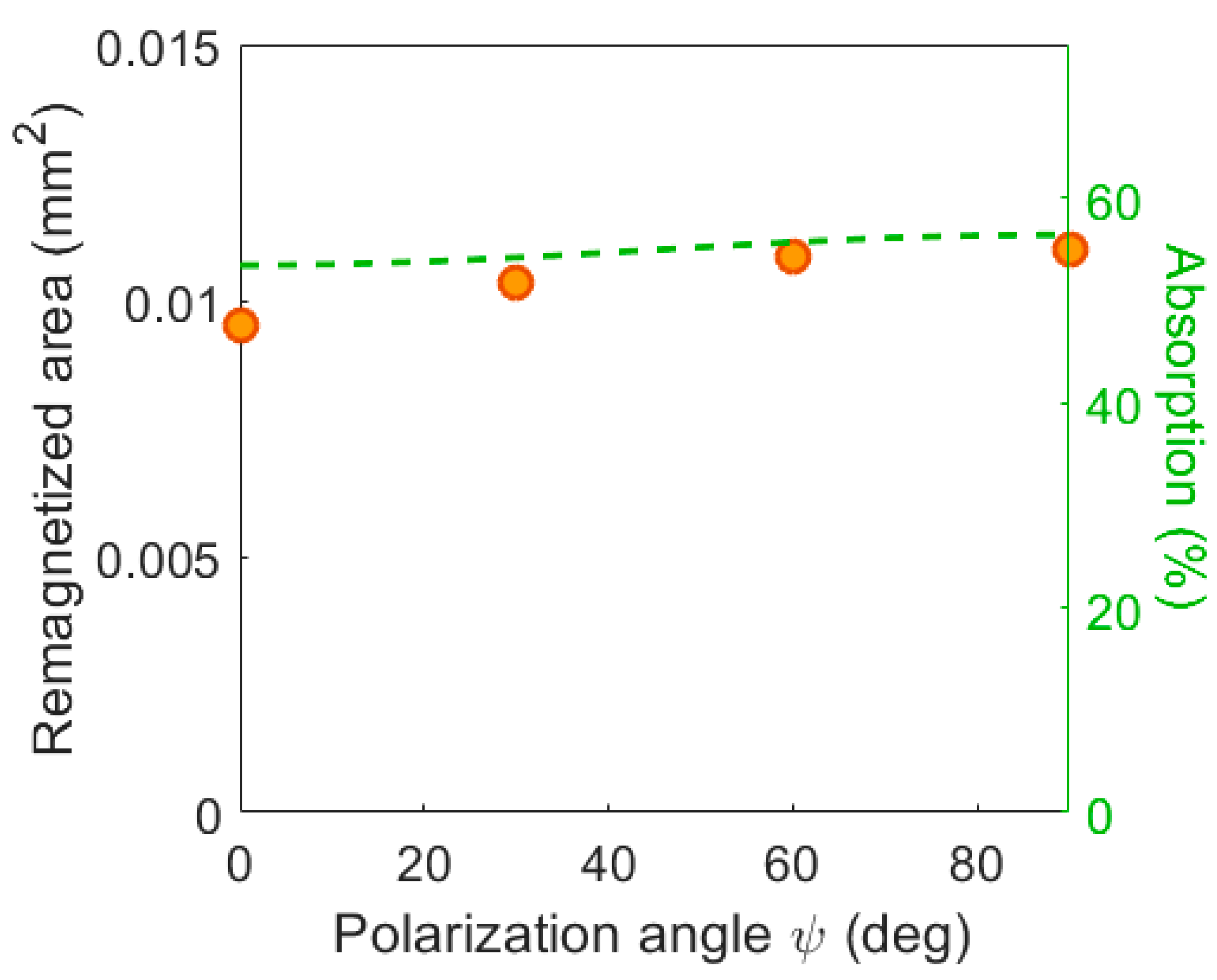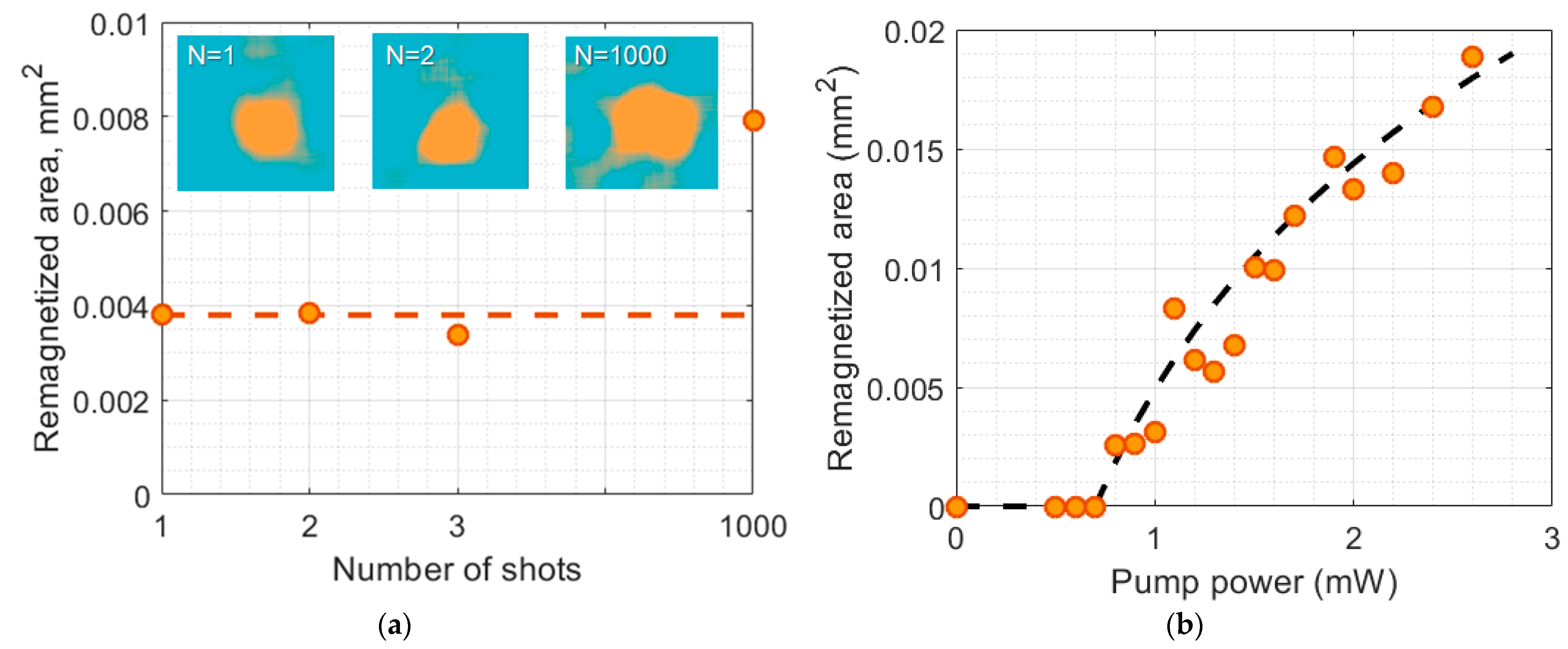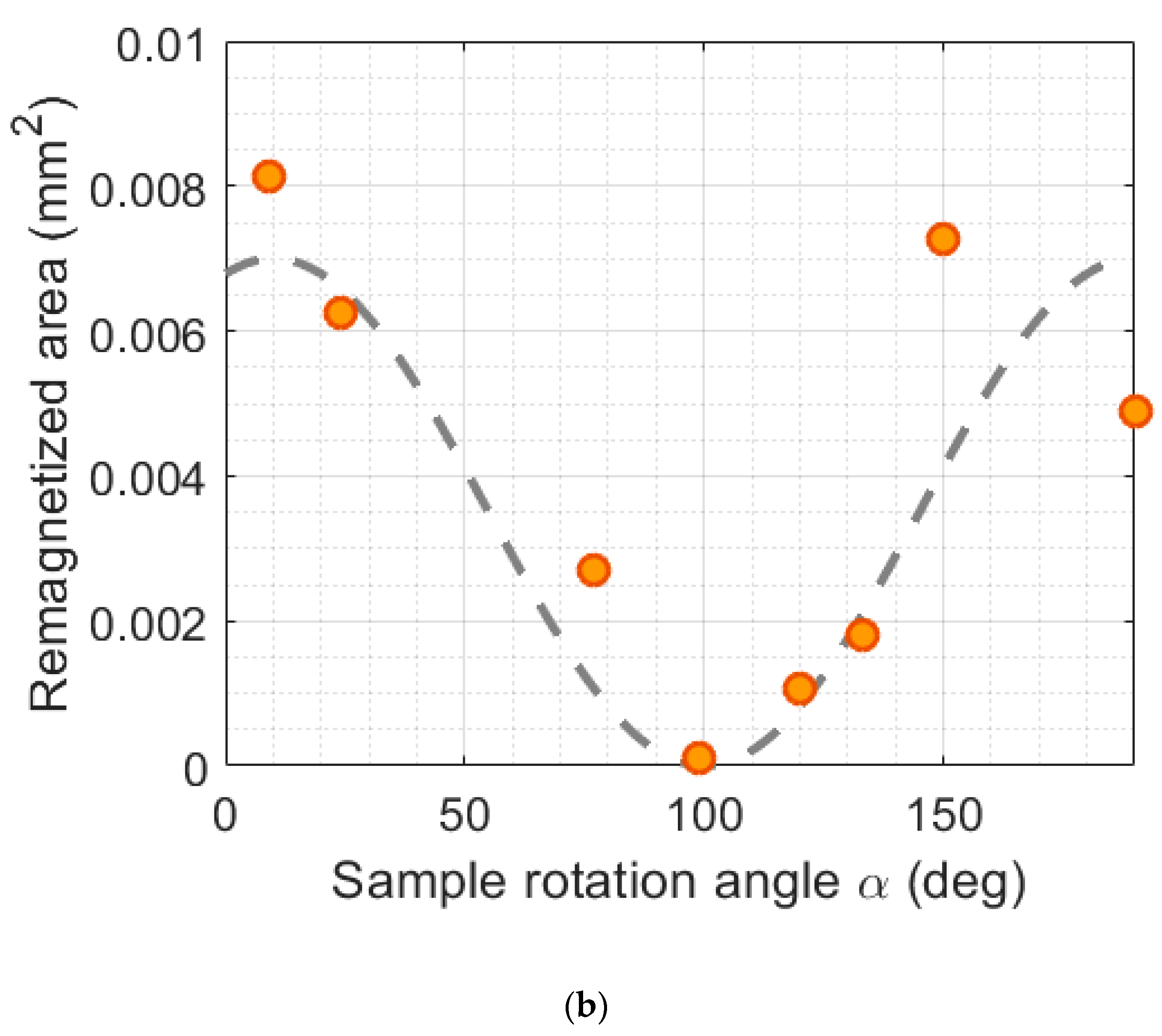Magnetization Switching in the GdFeCo Films with In-Plane Anisotropy via Femtosecond Laser Pulses
Abstract
:1. Introduction
2. Results and Discussion
2.1. Irreciprocal Magnetization Switching of GdFeCo Films via Femtosecond Laser Pulses
2.2. Impact of the Femtosecond Pump Parameters on the Irreciprocal Magnetization Switching Process
2.3. The Impact of the In-plane GdFeCo Film Anisotropy
2.4. The Impact of the External Magnetic Field
3. Materials and Methods
3.1. Fabrication of the In-Plane GdFeCo Films
3.2. Experimental Setup for Magnetization Switching
3.3. Processing of the CCD Images of the Magnetization State
4. Conclusions
Author Contributions
Funding
Institutional Review Board Statement
Informed Consent Statement
Data Availability Statement
Acknowledgments
Conflicts of Interest
Sample Availability
Appendix A

Appendix B

References
- Gschneidner, K.A.J.; Eyring, L. Handbook on the physics and chemistry of rare earths; North-Holland: Amsterdam, The Netherlands, 1984. [Google Scholar]
- Radu, I.; Vahaplar, K.; Stamm, C.; Kachel, T.; Pontius, N.; Dürr, H.A.; Ostler, T.A.; Barker, J.; Evans, R.F.L.; Chantrell, R.W.; et al. Transient ferromagnetic-like state mediating ultrafast reversal of antiferromagnetically coupled spins. Nature 2011, 472, 205–208. [Google Scholar] [CrossRef]
- Ostler, T.A.; Barker, J.; Evans, R.F.L.; Chantrell, R.W.; Atxitia, U.; Chubykalo-Fesenko, O.; El Moussaoui, S.; Le Guyader, L.; Mengotti, E.; Heyderman, L.J.; et al. Ultrafast heating as a sufficient stimulus for magnetization reversal in a ferrimagnet. Nat. Commun. 2012, 3, 666. [Google Scholar] [CrossRef] [Green Version]
- Le Guyader, L.; Savoini, M.; El Moussaoui, S.; Buzzi, M.; Tsukamoto, A.; Itoh, A.; Kirilyuk, A.; Rasing, T.; Kimel, A.V.; Nolting, F. Nanoscale sub-100 picosecond all-optical magnetization switching in GdFeCo microstructures. Nat. Commun. 2015, 6, 5839. [Google Scholar] [CrossRef] [PubMed] [Green Version]
- Graves, C.; Reid, A.H.; Wang, T.; Wu, B.; De Jong, S.; Vahaplar, K.; Radu, I.; Bernstein, D.P.; Messerschmidt, M.; Müller, L.; et al. Nanoscale spin reversal by non-local angular momentum transfer following ultrafast laser excitation in ferrimagnetic GdFeCo. Nat. Mater. 2013, 12, 293–298. [Google Scholar] [CrossRef] [PubMed]
- Mentink, J.H.; Hellsvik, J.; Afanasiev, D.V.; Ivanov, B.A.; Kirilyuk, A.; Kimel, A.V.; Eriksson, O.; Katsnelson, M.I.; Rasing, T. Ultrafast Spin Dynamics in Multisublattice Magnets. Phys. Rev. Lett. 2012, 108, 057202. [Google Scholar] [CrossRef] [PubMed]
- Koopmans, B.; Malinowski, G.; Longa, F.D.; Steiauf, D.; Fähnle, M.; Roth, T.; Cinchetti, M.; Aeschlimann, M. Explaining the paradoxical diversity of ultrafast laser-induced demagnetization. Nat. Mater. 2009, 9, 259–265. [Google Scholar] [CrossRef] [PubMed]
- Vahaplar, K.; Kalashnikova, A.M.; Kimel, A.V.; Gerlach, S.; Hinzke, D.; Nowak, U.; Chantrell, R.; Tsukamoto, A.; Itoh, A.; Kirilyuk, A.; et al. All-optical magnetization reversal by circularly polarized laser pulses: Experiment and multiscale modeling. Phys. Rev. B 2012, 85, 104402. [Google Scholar] [CrossRef]
- Beaurepaire, E.; Merle, J.-C.; Daunois, A.; Bigot, J.-Y. Ultrafast Spin Dynamics in Ferromagnetic Nickel. Phys. Rev. Lett. 1996, 76, 4250–4253. [Google Scholar] [CrossRef]
- Xu, C.; Weng, J.; Li, H.; Xiong, W. The influence of external magnetic field and femtosecond laser pulses on the anomalous Kerr loops in GdFeCo amorphous film. Optik (Stuttg). 2014, 125, 1735–1738. [Google Scholar] [CrossRef]
- Ciuciulkaite, A.; Mishra, K.; Moro, M.V.; Chioar, I.-A.; Rowan-Robinson, R.M.; Parchenko, S.; Kleibert, A.; Lindgren, B.; Andersson, G.; Davies, C.S.; et al. Magnetic and all-optical switching properties of amorphous TbxCo100-x alloys. Phys. Rev. Mater. 2020, 4, 104418. [Google Scholar] [CrossRef]
- Proenca, M.P.; Muñoz, M.; Villaverde, I.; Migliorini, A.; Raposo, V.; Lopez-Diaz, L.; Martinez, E.; Prieto, J.L. Deterministic and time resolved thermo-magnetic switching in a nickel nanowire. Sci. Rep. 2019, 9, 17339. [Google Scholar] [CrossRef] [Green Version]
- Hansen, P. Thermomagnetic switching in amorphous rare-earth transition metal alloys. J. Appl. Phys. 1987, 62, 216–230. [Google Scholar] [CrossRef]
- Hansen, P. Thermomagnetic switching in amorphous rare-earth transition-metal alloys with high compensation temperature. J. Appl. Phys. 1988, 63, 2364–2371. [Google Scholar] [CrossRef]
- Krumme, J. -P.; Hansen, P.; Witter, K. Thermomagnetic switching of ferrimagnetic garnet films at their compensation temperature. J. Appl. Phys. 1976, 47, 3681–3689. [Google Scholar] [CrossRef]
- Kimel, A.V.; Kirilyuk, A.; Usachev, P.A.; Pisarev, R.V.; Balbashov, A.M.; Rasing, T. Ultrafast non-thermal control of magnetization by instantaneous photomagnetic pulses. Nature 2005, 435, 655–657. [Google Scholar] [CrossRef]
- Savochkin, I.V.; Jäckl, M.; Belotelov, V.I.; Akimov, I.A.; Kozhaev, M.A.; Sylgacheva, D.A.; Chernov, A.I.; Shaposhnikov, A.N.; Prokopov, A.R.; Berzhansky, V.N.; et al. Generation of spin waves by a train of fs-laser pulses: A novel approach for tuning magnon wavelength. Sci. Rep. 2017, 7, 5668. [Google Scholar] [CrossRef] [PubMed] [Green Version]
- Jäckl, M.; Belotelov, V.I.; Akimov, I.A.; Savochkin, I.V.; Yakovlev, D.R.; Zvezdin, A.K.; Bayer, M. Magnon Accumulation by Clocked Laser Excitation as Source of Long-Range Spin Waves in Transparent Magnetic Films. Phys. Rev. X 2017, 7, 021009. [Google Scholar] [CrossRef] [Green Version]
- Belotelov, V.I.; Zvezdin, A.K. Inverse transverse magneto-optical Kerr effect. Phys. Rev. B 2012, 86, 155133. [Google Scholar] [CrossRef] [Green Version]
- Chernov, A.I.; Kozhaev, M.A.; Ignatyeva, D.O.; Beginin, E.N.; Sadovnikov, A.V.; Voronov, A.; Karki, D.; Levy, M.; Belotelov, V.I. All-Dielectric Nanophotonics Enables Tunable Excitation of the Exchange Spin Waves. Nano Lett. 2020, 20, 5259–5266. [Google Scholar] [CrossRef] [PubMed]
- Stupakiewicz, A.; Szerenos, K.; Afanasiev, D.; Kirilyuk, A.; Kimel, A.V. Ultrafast nonthermal photo-magnetic recording in a transparent medium. Nature 2017, 542, 71–74. [Google Scholar] [CrossRef]
- Im, S.-J.; Pae, J.-S.; Ri, C.-S.; Ho, K.-S.; Herrmann, J. All-optical magnetization switching by counterpropagataion or two-frequency pulses using the plasmon-induced inverse Faraday effect in magnetoplasmonic structures. Phys. Rev. B 2019, 99, 041401. [Google Scholar] [CrossRef] [Green Version]
- Khorsand, A.R.; Savoini, M.; Kirilyuk, A.; Kimel, A.V.; Tsukamoto, A.; Itoh, A.; Rasing, T. Role of Magnetic Circular Dichroism in All-Optical Magnetic Recording. Phys. Rev. Lett. 2012, 108, 127205. [Google Scholar] [CrossRef]
- Savoini, M.; Medapalli, R.; Koene, B.; Khorsand, A.R.; Le Guyader, L.; Duò, L.; Finazzi, M.; Tsukamoto, A.; Itoh, A.; Nolting, F.; et al. Highly efficient all-optical switching of magnetization in GdFeCo microstructures by interference-enhanced absorption of light. Phys. Rev. B 2012, 86, 140404. [Google Scholar] [CrossRef] [Green Version]
- Borovkova, O.V.; Ignatyeva, D.O.; Belotelov, V.I. Layer-selective magnetization switching in the chirped photonic crystal with GdFeCo. Sci. Rep. 2021, 11, 2239. [Google Scholar] [CrossRef] [PubMed]
- Liu, T.-M.; Wang, T.; Reid, A.H.; Savoini, M.; Wu, X.; Koene, B.; Granitzka, P.; Graves, C.E.; Higley, D.J.; Chen, Z.; et al. Nanoscale Confinement of All-Optical Magnetic Switching in TbFeCo-Competition with Nanoscale Heterogeneity. Nano Lett. 2015, 15, 6862–6868. [Google Scholar] [CrossRef]
- Zhou, N.; Xu, X.; Hammack, A.T.; Stipe, B.C.; Gao, K.; Scholz, W.; Gage, E.C. Plasmonic near-field transducer for heat-assisted magnetic recording. Nanophotonics 2014, 3, 141–155. [Google Scholar] [CrossRef]
- Ignatyeva, D.O.; Davies, C.S.; Sylgacheva, D.A.; Tsukamoto, A.; Yoshikawa, H.; Kapralov, P.O.; Kirilyuk, A.; Belotelov, V.I.; Kimel, A.V. Plasmonic layer-selective all-optical switching of magnetization with nanometer resolution. Nat. Commun. 2019, 10, 4786. [Google Scholar] [CrossRef]
- Dutta, A.; Kildishev, A.V.; Shalaev, V.M.; Boltasseva, A.; Marinero, E.E. Surface-plasmon opto-magnetic field enhancement for all-optical magnetization switching. Opt. Mater. Express 2017, 7, 4316–4327. [Google Scholar] [CrossRef] [Green Version]
- Torrado, J.F.; González-Díaz, J.B.; González, M.U.; García-Martín, A.; Armelles, G. Magneto-optical effects in interacting localized and propagating surface plasmon modes. Opt. Express 2010, 18, 15635–15642. [Google Scholar] [CrossRef] [Green Version]
- Maccaferri, N.; Inchausti, X.; Garcia-Martin, A.; Cuevas, J.C.; Tripathy, D.; Adeyeye, A.O.; Vavassori, P. Resonant Enhancement of Magneto-Optical Activity Induced by Surface Plasmon Polariton Modes Coupling in 2D Magnetoplasmonic Crystals. ACS Photon- 2015, 2, 1769–1779. [Google Scholar] [CrossRef]
- Belotelov, V.I.; Bykov, D.A.; Doskolovich, L.L.; Kalish, A.N.; Kotov, V.A.; Zvezdin, A.K. Giant magneto-optical orientational effect in plasmonic heterostructures. Opt. Lett. 2009, 34, 398–400. [Google Scholar] [CrossRef]
- Khramova, A.E.; Ignatyeva, D.O.; Kozhaev, M.A.; Dagesyan, S.A.; Berzhansky, V.N.; Shaposhnikov, A.N.; Tomilin, S.V.; Belotelov, V.I. Resonances of the magneto-optical intensity effect mediated by interaction of different modes in a hybrid magnetoplasmonic heterostructure with gold nanoparticles. Opt. Express 2019, 27, 33170–33179. [Google Scholar] [CrossRef] [PubMed] [Green Version]
- Ostler, T.A.; Evans, R.F.L.; Chantrell, R.W.; Atxitia, U.; Chubykalo-Fesenko, O.; Radu, I.; Abrudan, R.; Radu, F.; Tsukamoto, A.; Itoh, A.; et al. Crystallographically amorphous ferrimagnetic alloys: Comparing a localized atomistic spin model with experiments. Phys. Rev. B 2011, 84, 024407. [Google Scholar] [CrossRef] [Green Version]
- Ding, M.; Poon, S.J. Tunable perpendicular magnetic anisotropy in GdFeCo amorphous films. J. Magn. Magn. Mater. 2013, 339, 51–55. [Google Scholar] [CrossRef] [Green Version]






Publisher’s Note: MDPI stays neutral with regard to jurisdictional claims in published maps and institutional affiliations. |
© 2021 by the authors. Licensee MDPI, Basel, Switzerland. This article is an open access article distributed under the terms and conditions of the Creative Commons Attribution (CC BY) license (https://creativecommons.org/licenses/by/4.0/).
Share and Cite
Ignatyeva, D.O.; Kapralov, P.O.; Prabhakara, K.H.; Yoshikawa, H.; Tsukamoto, A.; Belotelov, V.I. Magnetization Switching in the GdFeCo Films with In-Plane Anisotropy via Femtosecond Laser Pulses. Molecules 2021, 26, 6406. https://doi.org/10.3390/molecules26216406
Ignatyeva DO, Kapralov PO, Prabhakara KH, Yoshikawa H, Tsukamoto A, Belotelov VI. Magnetization Switching in the GdFeCo Films with In-Plane Anisotropy via Femtosecond Laser Pulses. Molecules. 2021; 26(21):6406. https://doi.org/10.3390/molecules26216406
Chicago/Turabian StyleIgnatyeva, Daria O., Pavel O. Kapralov, Kiran Horabail Prabhakara, Hiroki Yoshikawa, Arata Tsukamoto, and Vladimir I. Belotelov. 2021. "Magnetization Switching in the GdFeCo Films with In-Plane Anisotropy via Femtosecond Laser Pulses" Molecules 26, no. 21: 6406. https://doi.org/10.3390/molecules26216406





